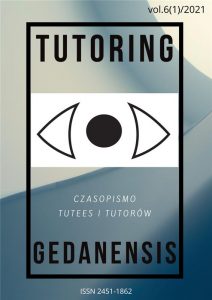Czy bioaerozole są stałym elementem naszego otoczenia?
DOI:
https://doi.org/10.26881/tutg.2021.1.05Słowa kluczowe:
bioaerozole, toksyny, atmosfera, środowiskoDownloads
Bibliografia
Abraham, W.M., Ahmed, A., Bourdelais, A.J., Baden, D.G., 2004. Effects of novel antagonists of polyetherbrevetoxin on PbTx- induced bronchioconstriction in allergic sheep. [w:] Steidinger, K.A., Landsberg, J.H., Tomas, C.R., Vargo, G.A., (red.), Harmful Algae 2002. Florida Fish and Wildlife Conservation Commission, Florida Institute of Oceanography and Intergovernmental Oceanographic Commission of UNESCO, pp. 496-498.
Burge, H. A., and Rogers Ch. A., 2000. Outdoor allergens. Environmental Health Perspectives 108.suppl 4, 653-659.
Charlson, R. J., Schwartz, S. E., Hales, J. M., Cess, R. D., Coakley, J. J., Hansen, J. E., & Hofmann, D. J., 1992. Climate forcing by anthropogenic aerosols. Science, 255(5043), 423-430.
Cheng, Y.S.; Yue, Z.; Irvin, C.M.; Kirkpatrick, B.; Backer, L.C., 2007, Characterization of aerosols containing microcystin. Marine drugs 5.4: 136-150.
Ciminiello, P., Dell’Aversano, C., Iacovo, E. D., Fattorusso, E., Forino, M., Tartaglione, L., & Penna, A., 2014. First finding of Ostreopsis cf. ovata toxins in marine aerosols. Environmental science & technology, 48(6), 3532-3540.
Després, V.R., Huffman, J.A., Burrows, S.M., Hoose, C., Safatov, A.S., Buryak, G., Fröhlich- Nowoisky, J., Elbert, W., Andreae, M.O., Pöschl, U., Jaenicke, E., 2012. Primary biological aerosol particles in the atmosphere: a review. Tellus Ser. B Chem. Phys. Meteorol. 64, 15598-15656.
Dopierała, Ł., Śliwińska S., Latała A., 2013. The Effects of Harmful Algal Blooms (Habs) on Tourism and Recreation in the East Part of The Polish Baltic Sea Coast. Zeszyty Naukowe Uniwersytetu Szczecińskiego. Ekonomiczne Problemy Turystyki 1 (21): 53-63.
Finkelstein, M. M., Jerrett, M., Sears, M. R., 2004. Traffic air pollution and mortality rate advancement periods. American Journal of Epidemiology, 160(2), 173-177.
Fujiki, H., & Suganuma, M., 2011. Tumor promoters-microcystin-LR, nodularin and TNF-α and human cancer development. AntiCancer Agents in Medicinal Chemistry, 11(1), 4-18.
Glasgow Jr, H. B., Burkholder, J. M., Schmechel, D. E., Tester, P. A., & Rublee, P. A., 1995. Insidious effects of a toxic estuarine dinoflagellate on fish survival and human health. Journal of Toxicology and Environmental Health, Part A Current Issues, 46(4), 501-522.
Kennedy, I. M., 2007. The health effects of combustion-generated aerosols. Proceedings of the Combustion Institute, 31, 2757- 2770.
Kruczalak, K., Olańczuk-Neyman, K., Marks, R., 2002. Airborne Microorganisms Fluctuations over the Gulf of Gdańsk Coastal Zone (Southern Baltic). Polish Journal of Environmental Studies. 11, 531-536.
Lewandowska, A., Śliwińska-Wilczewska, S., Wozniczka, D., 2017. Identification of cyanobacteria and microal- gae in aerosols of various sizes in the air over the southern Baltic Sea. Marine Pollution Bulletin. 125: 30-38.
Marks, R., Jankowska, K., Michalska, M., Królska, M. 2001. Sea to air bacteria transfer over the Baltic Sea coast and Gulf of Gdańsk. Journal of Aerosol Science. 28 (1) 593-594.
Marks, R., Górecka, E., McCartney, K., Borkowski, W., 2019. Rising bubbles as mechanism for scavenging and aerosolization of diatoms. Journal of Aerosol Science 128: 79- 88.
Medina-Pérez, N., Dall'osto, M., Decesari, S., Paglione, M., Moyano, E., Berdalet, E., 2021. Aerosol Toxins Emitted by Harmful Algal Blooms Susceptible to Complex Air-Sea Interactions. Environmental Science and Technology 55(1) 468-477.
Michalska, M., Bartoszewicz, M., Cieszyńska, M., Nowacki, J., 2010. Bioaerosols on Tri-city (Gdańsk-Sopot-Gdynia) beaches. Int Marit Health 61: 41-43.
Miquel, P. 1883. Les Organismes Vivants de l’atmosphere. Gauthier-Villars, Paris.
Olson, N. E., Cooke, M. E., Shi, J. H., Birbeck, J. A., Westrick, J. A., & Ault, A. P., 2020. Harmful algal bloom toxins in aerosol generated from inland lake water. Environmental science & technology, 54(8), 4769- 4780.
Pierce, R. H., Henry, M. S., Blum, P. C., Hamel, S. L., Kirkpatrick, B., Cheng, Y. S., Zhou, Y., Irvin, C. M., Naar, J., Weidner, A., Fleming, L. E., Backer, L. C., Baden, D. G., 2005. Brevetoxin composition in water and marine aerosol along a Florida beach: Assessing potential human exposure to marine biotoxins. Harmful Algae.; 64: 965-972.
Plaas, H. E., Paerl, H. W., 2020. Toxic cyanobacteria: a growing threat to water and air quality. Environmental science & technology 55.1 (): 44-64.
Pöschl U., 2005: Atmospheric Aerosols: Composition, Transformation, Climate and Health Effects., Atmopsheric Chemistry., Volume 44, 7520-7540.
Usami, M., Satake, M., Ishida, S., Inoue, A., Kan, Y., & Yasumoto, T., 1995. Palytoxin analogs from the dinoflagellate Ostreopsis siamensis. Journal of the American chemical society, 117(19), 5389-5390.
Van Dolah, Frances M., 2000. Marine algal toxins: origins, health effects, and their increased occurrence." Environmental health perspectives 108.suppl 1: 133-141.
Wasmund, N., 1997. Occurrence of cyanobacterial blooms in the Baltic Sea in relation to environmental conditions. Internationale Revue der gesamten Hydrobiologie und Hydrographie, 82(2), 169-184.
Wiśniewska K, Lewandowska A, Śliwińska-Wilczewska S., 2019. The importance of cyanobacteria and microalgae present in aerosols to human health and the environment. Review study. Environment International. 2019; 131: 104964.
Zingone, A., Oksfeldt Enevoldsen, H., 2000. The diversity of harmful algal blooms: a challenge for science and management. Ocean & coastal management 43.8-9: 725-748.
Źródła internetowe:
https://mobirank.pl/2020/01/31/raport-digital-i-mobile-na-swiecie-w-2020-roku/
Kolekcja Kultur Glonów Bałtyckich: https://ccba.ug.edu.pl/pages/pl/przeglad-kolekcji.php?section_id=19&page=1&pochodzenie=1&klasa=1&rodzaj=all&gatunek=all&symbol=all

 Uniwersyteckie Czasopisma Naukowe
Uniwersyteckie Czasopisma Naukowe



